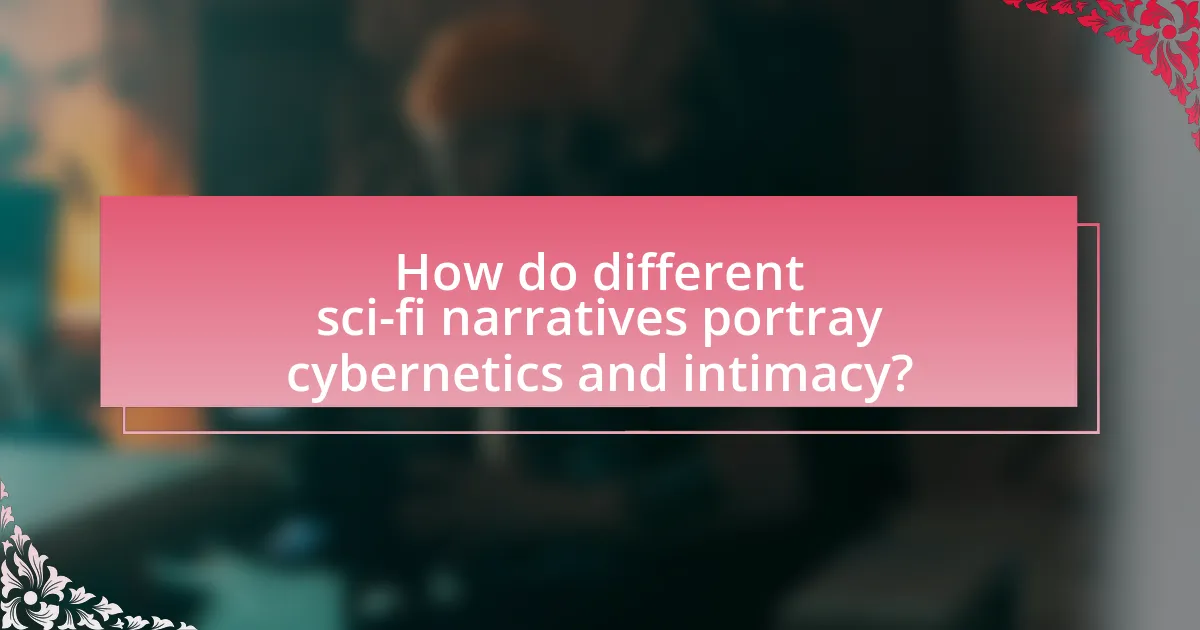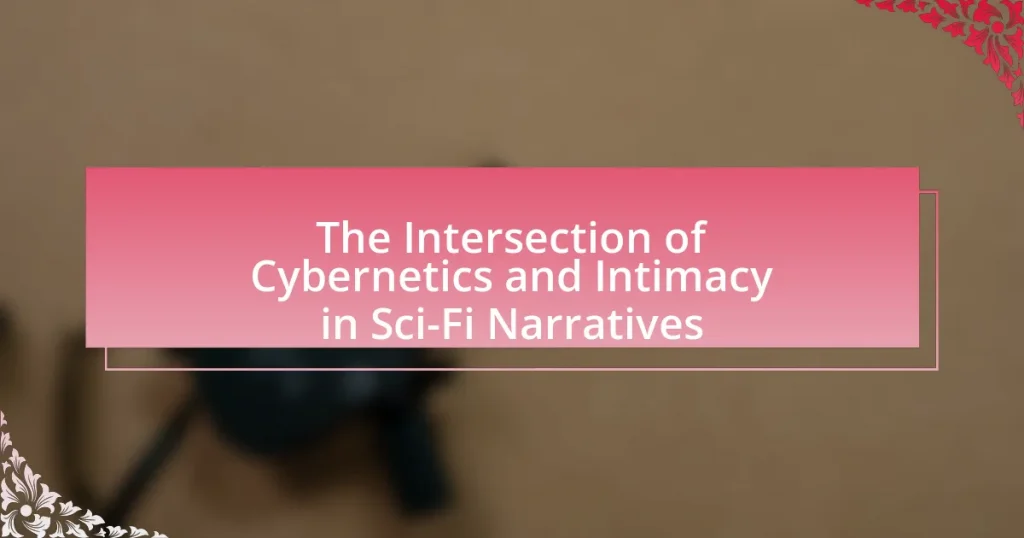The article examines the intersection of cybernetics and intimacy in science fiction narratives, focusing on how technology influences human relationships and emotional connections. It highlights key themes such as human-machine relationships, the redefinition of identity, and the implications of emotional connectivity in a technologically advanced society. Notable examples from literature and film, including “Neuromancer” and “Her,” illustrate the complexities of intimacy in the context of cybernetic enhancements. The article also addresses societal views on technology’s role in relationships, ethical considerations, and the potential impact of future advancements on human interaction.

What is the Intersection of Cybernetics and Intimacy in Sci-Fi Narratives?
The intersection of cybernetics and intimacy in sci-fi narratives explores how technology influences human relationships and emotional connections. In various works, such as “Neuromancer” by William Gibson, cybernetic enhancements blur the lines between human and machine, raising questions about the authenticity of intimacy. These narratives often depict characters forming bonds with artificial intelligences or cyborgs, illustrating the complexities of love and connection in a technologically advanced society. This thematic exploration reflects societal anxieties about dependency on technology and the evolving nature of human interaction in the digital age.
How do cybernetics and intimacy converge in science fiction?
Cybernetics and intimacy converge in science fiction through the exploration of human-machine relationships that challenge traditional notions of connection and emotional bonding. In narratives such as “Her” by Spike Jonze, the protagonist develops a deep emotional relationship with an artificial intelligence, illustrating how technology can facilitate intimate connections. This convergence is further evidenced in works like “Ghost in the Shell,” where cyborgs navigate complex identities and relationships, blurring the lines between human and machine. These examples highlight how science fiction uses cybernetic themes to examine the evolving nature of intimacy in a technologically advanced society.
What are the key themes that emerge from this intersection?
The key themes that emerge from the intersection of cybernetics and intimacy in sci-fi narratives include the exploration of human-machine relationships, the redefinition of identity, and the implications of emotional connectivity in a technologically advanced society. Human-machine relationships are often depicted as complex, raising questions about the nature of love and companionship when technology is involved. The redefinition of identity occurs as characters navigate their humanity in relation to cybernetic enhancements, leading to existential dilemmas about what it means to be human. Additionally, emotional connectivity is examined through the lens of technology, highlighting both the potential for deeper connections and the risks of alienation in a digital age. These themes are prevalent in works such as “Neuromancer” by William Gibson, which illustrates the blending of human consciousness with technology, and “Her” directed by Spike Jonze, which explores romantic relationships with artificial intelligence.
How do these themes reflect societal views on technology and relationships?
Themes in sci-fi narratives about the intersection of cybernetics and intimacy reflect societal views on technology as both a facilitator and a barrier in relationships. These narratives often illustrate how technology can enhance emotional connections through virtual communication and shared experiences, as seen in works like “Her” by Spike Jonze, where an artificial intelligence forms a deep bond with a human. Conversely, they also highlight the potential for technology to create isolation and superficial interactions, as depicted in “Black Mirror,” where reliance on devices leads to disconnection from genuine human experiences. This duality underscores a societal ambivalence towards technology, recognizing its capacity to enrich relationships while also posing risks to authentic intimacy.
Why is the exploration of intimacy important in cybernetic narratives?
The exploration of intimacy is important in cybernetic narratives because it reveals the complex relationships between humans and technology. These narratives often depict how technological advancements impact emotional connections, highlighting both the potential for enhanced communication and the risks of alienation. For instance, in works like “Her” by Spike Jonze, the protagonist develops a deep emotional bond with an artificial intelligence, illustrating how intimacy can transcend traditional boundaries. This exploration is crucial as it prompts critical discussions about identity, agency, and the ethical implications of merging human experiences with cybernetic systems.
How does intimacy influence character development in these narratives?
Intimacy significantly influences character development in sci-fi narratives by fostering emotional connections that drive personal growth and conflict resolution. In these stories, characters often navigate complex relationships with technology and each other, which can lead to transformative experiences. For instance, the bond between humans and artificial intelligences can reveal vulnerabilities and strengths, prompting characters to confront their identities and moral dilemmas. This dynamic is evident in works like “Her” by Spike Jonze, where the protagonist’s intimate relationship with an AI leads to profound self-discovery and emotional evolution. Such narratives illustrate how intimacy serves as a catalyst for character development, shaping their arcs through the interplay of connection and technology.
What role does emotional connection play in cybernetic interactions?
Emotional connection significantly enhances cybernetic interactions by fostering trust and engagement between humans and machines. This connection allows users to feel more comfortable and invested in their interactions with technology, leading to improved user experiences and outcomes. Research indicates that emotional engagement can increase user satisfaction and loyalty, as seen in studies where emotionally responsive AI systems led to higher user retention rates. For instance, a study published in the journal “Computers in Human Behavior” by authors such as Bickmore and Picard demonstrates that emotionally aware systems can create a sense of companionship, which is crucial for effective communication and collaboration in cybernetic environments.

How do different sci-fi narratives portray cybernetics and intimacy?
Different sci-fi narratives portray cybernetics and intimacy by exploring the complex relationships between humans and machines, often highlighting themes of connection, alienation, and the redefinition of personal boundaries. For instance, in “Ghost in the Shell,” the integration of cybernetic enhancements raises questions about identity and emotional connection, as characters grapple with their humanity in a technologically advanced society. Similarly, in “Blade Runner,” the replicants’ quest for emotional experiences challenges the notion of intimacy, blurring the lines between human and artificial relationships. These narratives illustrate how cybernetics can enhance or complicate intimacy, reflecting societal anxieties about technology’s impact on human connections.
What are some notable examples of this intersection in literature and film?
Notable examples of the intersection of cybernetics and intimacy in literature and film include “Neuromancer” by William Gibson and the film “Her” directed by Spike Jonze. In “Neuromancer,” the protagonist Case navigates a world where human consciousness interfaces with technology, exploring themes of identity and connection. Similarly, “Her” portrays a romantic relationship between a man and an artificial intelligence, highlighting emotional intimacy facilitated by advanced technology. Both works illustrate how cybernetic elements can profoundly affect human relationships and emotional experiences.
How do these examples differ in their portrayal of intimacy?
The examples differ in their portrayal of intimacy by contrasting emotional connection with technological interaction. One example may depict intimacy as a deep emotional bond between characters, emphasizing vulnerability and trust, while another may illustrate intimacy through the lens of technology, showcasing interactions mediated by artificial intelligence or virtual environments. For instance, a narrative focusing on human relationships might highlight shared experiences and physical presence, whereas a story centered on cybernetic elements could portray intimacy as a simulation of connection, lacking genuine emotional depth. This distinction underscores the varying interpretations of intimacy in the context of human relationships versus technologically mediated experiences.
What impact do these portrayals have on audience perceptions of technology?
Portrayals of technology in sci-fi narratives significantly shape audience perceptions by influencing their understanding of technological possibilities and ethical implications. These narratives often depict advanced technologies, such as artificial intelligence and cybernetic enhancements, which can evoke both fascination and fear among viewers. For instance, films like “Blade Runner” and series like “Black Mirror” explore the consequences of technology on human relationships and societal structures, prompting audiences to reflect on real-world technological advancements. Research indicates that such portrayals can lead to increased public discourse on technology’s role in society, as seen in studies by the Pew Research Center, which highlight how media representations affect public attitudes toward emerging technologies.
How do cultural contexts shape the depiction of cybernetics and intimacy?
Cultural contexts significantly shape the depiction of cybernetics and intimacy by influencing societal values, technological perceptions, and interpersonal relationships. For instance, in Western cultures, cybernetics often emphasizes individualism and autonomy, leading to narratives that explore personal identity through technology, such as in films like “Her,” where a man’s emotional connection with an AI reflects contemporary anxieties about loneliness and connection. Conversely, in collectivist cultures, such as those in East Asia, cybernetic intimacy may focus on community and relational harmony, as seen in works like “Ghost in the Shell,” where technology is integrated into social structures and collective identity. These cultural frameworks dictate how intimacy is portrayed, whether as a means of enhancing personal freedom or as a tool for fostering social cohesion, thus illustrating the profound impact of cultural contexts on the narrative construction of cybernetics and intimacy.
What cultural factors influence the narrative choices in these stories?
Cultural factors such as societal norms, technological advancements, and historical context significantly influence the narrative choices in stories exploring the intersection of cybernetics and intimacy. For instance, the portrayal of relationships with artificial intelligence often reflects contemporary anxieties about technology’s role in human connection, as seen in works like “Her” by Spike Jonze, which examines emotional intimacy in a digital age. Additionally, cultural attitudes towards gender and identity shape character dynamics and plot developments, as evidenced in “Ghost in the Shell,” where themes of identity and embodiment challenge traditional notions of self. These narratives often mirror real-world discussions about the implications of technology on personal relationships, highlighting how cultural perceptions inform storytelling in the sci-fi genre.
How do different cultures interpret the relationship between technology and human connection?
Different cultures interpret the relationship between technology and human connection in varied ways, often influenced by their historical, social, and philosophical contexts. For instance, in collectivist cultures like Japan, technology is frequently viewed as a means to enhance social harmony and community engagement, as seen in the widespread use of social media platforms that facilitate group interactions. Conversely, in individualistic cultures such as the United States, technology is often perceived as a tool for personal expression and autonomy, leading to a focus on individual connections rather than communal ties. Research by the Pew Research Center indicates that cultural attitudes towards technology significantly shape how individuals perceive its impact on relationships, with 72% of Americans believing that technology improves communication, while in countries like South Korea, the emphasis is placed on technology fostering deeper social bonds.

What are the implications of cybernetics on future relationships?
Cybernetics will significantly alter future relationships by enhancing communication and emotional connectivity through technology. As cybernetic systems integrate with human interactions, they will enable real-time data exchange, allowing individuals to share thoughts and feelings more transparently. This transformation is evidenced by advancements in brain-computer interfaces, which have shown potential in facilitating direct communication between minds, as seen in research by Nicolelis et al. (2011) on neural interfaces. Furthermore, the use of artificial intelligence in relationship management can lead to personalized experiences, fostering deeper emotional bonds. These developments suggest that cybernetics will redefine intimacy, making relationships more interconnected and potentially more complex.
How might advancements in cybernetics change our understanding of intimacy?
Advancements in cybernetics could fundamentally alter our understanding of intimacy by enabling deeper emotional connections through enhanced communication technologies. These technologies, such as brain-computer interfaces, allow individuals to share thoughts and feelings directly, potentially transcending traditional barriers of verbal and physical communication. Research indicates that such interfaces can facilitate empathy and understanding, as demonstrated in studies where participants experienced shared emotional states through neural synchronization. This capability may redefine intimacy, shifting it from physical presence to a more profound, interconnected experience that emphasizes emotional resonance over physical interaction.
What ethical considerations arise from merging technology with personal relationships?
Merging technology with personal relationships raises significant ethical considerations, primarily concerning privacy, consent, and emotional authenticity. Privacy issues arise as technology often collects and analyzes personal data, potentially leading to breaches of trust and confidentiality. For instance, social media platforms can expose intimate details of relationships without explicit consent, undermining the privacy of individuals involved.
Consent becomes complex when technology mediates interactions, as individuals may not fully understand the implications of sharing personal information or engaging with AI-driven platforms. This lack of informed consent can lead to manipulation or exploitation, particularly in vulnerable populations.
Emotional authenticity is also at stake; technology can create artificial connections that may replace genuine human interaction. Research indicates that reliance on digital communication can diminish the quality of interpersonal relationships, as seen in studies showing that increased screen time correlates with feelings of loneliness and social isolation.
These ethical considerations highlight the need for careful navigation of technology’s role in personal relationships to ensure respect for individual autonomy and emotional well-being.
How can we prepare for the potential changes in human interaction?
To prepare for potential changes in human interaction, individuals and societies should prioritize the development of digital literacy and emotional intelligence. Digital literacy equips people to navigate new technologies that influence communication, while emotional intelligence fosters understanding and empathy in increasingly virtual interactions. Research indicates that as technology evolves, the ability to connect emotionally remains crucial; for instance, a study by the Pew Research Center found that 82% of experts believe that emotional intelligence will be essential in future workplaces influenced by technology. By focusing on these skills, we can enhance our adaptability to changing interaction dynamics.
What lessons can we learn from sci-fi narratives about cybernetics and intimacy?
Sci-fi narratives about cybernetics and intimacy teach us that technology can profoundly alter human relationships and emotional connections. These narratives often explore themes of enhanced communication, the merging of human and machine, and the potential for both intimacy and alienation. For instance, in “Ghost in the Shell,” the integration of cybernetic enhancements raises questions about identity and the essence of human connection, illustrating how technology can both facilitate and complicate intimacy. Additionally, works like “Her” demonstrate how artificial intelligence can create deep emotional bonds, highlighting the complexities of love and attachment in a technologically mediated world. These examples underscore the dual nature of cybernetics in shaping intimacy, revealing both opportunities for connection and challenges to authentic human experience.
How can these narratives inform our approach to technology in relationships?
Sci-fi narratives exploring the intersection of cybernetics and intimacy can inform our approach to technology in relationships by highlighting the complexities and ethical considerations of human-technology interactions. These narratives often depict scenarios where technology enhances or complicates emotional connections, illustrating the potential for both intimacy and alienation. For example, in the film “Her,” the protagonist develops a deep emotional bond with an AI, prompting discussions about the nature of love and companionship in a digital age. Such stories encourage critical reflection on how technology can shape our emotional landscapes, urging us to consider the implications of reliance on digital interfaces for connection. By analyzing these narratives, we can better understand the balance between leveraging technology to foster intimacy and recognizing its limitations in replicating genuine human experiences.
What best practices can we adopt to maintain intimacy in a tech-driven world?
To maintain intimacy in a tech-driven world, individuals should prioritize face-to-face interactions and establish boundaries around technology use. Research indicates that in-person communication fosters deeper emotional connections, as it allows for non-verbal cues and genuine engagement, which are often lost in digital communication. Additionally, setting specific times to disconnect from devices can enhance quality time spent together, reinforcing emotional bonds. A study published in the Journal of Social and Personal Relationships found that couples who regularly engage in tech-free activities report higher levels of relationship satisfaction. By consciously choosing to limit technology’s intrusion into personal interactions, individuals can cultivate a more intimate and connected relationship.













